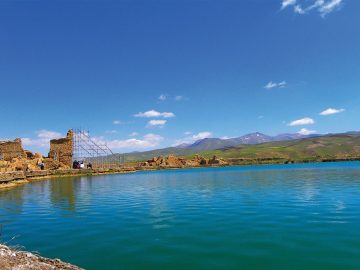
Takht- e Soleyman was a principal sacred place of Zoroastrianism, the Sassanid (224 – 650 CE) State faith that influenced monotheism. The general layout of the site became an architectural reference for East and West architecture, especially Islamic architecture. Takht-e Soleyman also has strong symbolic significance about the continuation of a cult related to fire and water over the last 2,500 years.
The site consists of an artesian spring-lake, Azar Goshnasp Zoroastrian fire temple, a temple dedicated to Anahita (the divinity of the waters), a Sasanian royal sanctuary, an ancient volcano, Zendan-e Soleyman (Prison of Solomon), and remains of temples older than burgeon of Zoroastrianism.

Located in ancient Ganzak or Shiz, Azar Goshnasp fire temple housed one of the three revered Great Fires dedicated to the warrior class of the Sasanid. In 624 AC the Roman Heraclius attacked Ganzak and destroyed Azar Goshnasp. The chahartaq (an architectural unit consisted of four barrel vaults and a dome used for keeping the sacred fire in Zoroastrianism) with surrounding corridors is located on the north side of the spring-lake.

The biggest construction on the site was Sassanid royal court with rooms of different size surrounding an iwan. The three rooms at its western front have wide openings to the outside perhaps for ceremonial purposes, and the iwan opens to the north side of the lake. Because of destructions and reconstructions in the Sassanid era, different materials including mud bricks, baked bricks, and stone are used in the buildings.
The site obtained its name after the Arab conquests. According to folkloric legend, King Solomon (whose name is come in Hebrew Bible, Old Testament, and Quran) incarcerated monsters inside a nearby 100 meters-deep crater known as Zendan-e Soleyman or prison of Solomon.


